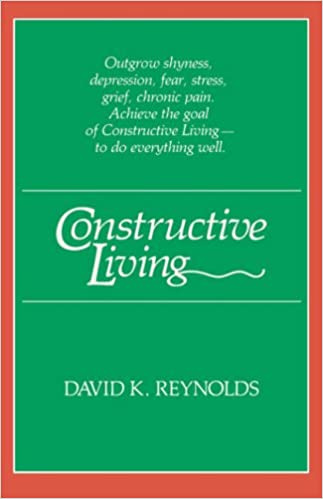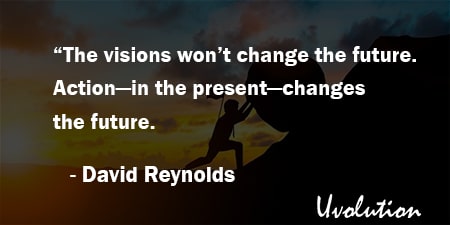Constructive Living by David Reynolds
The Book in 1 Sentences
“There are no neurotics or geniuses or failures or fools. There are only neurotic moments, flashes of brilliance, failed opportunities, and stupid mistakes. But these moments, pleasant or unpleasant, can never fix us into rigid, immutable characters. We cannot help but change. This book is about choosing the direction of your changingness and acting upon your choice.” ~ David K. Reynolds
5 BIG Ideas
1. The mature human being goes about doing what needs to be done regardless of whether that person feels great or terrible.
2. The more control we develop over our actions, the more chance we have of producing a self we can be proud of.
3. The visions won’t change the future. Action—in the present—changes the future.
4. In any situation ask yourself: “Now what needs to be done?”
5. Mastery of life grows slowly, painfully, and only with effort.
Constructive Living Book Summary
1. Self-Control = Confidence
“The mature human being goes about doing what needs to be done regardless of whether that person feels great or terrible. Knowing that you are the kind of person with that kind of self-control brings all the satisfaction and confidence you will ever need. Even on days when the satisfaction and confidence just aren’t there, you can get the job done anyway.”
“That’s the ultimate goal of Constructive Living—to help you do everything well, with full attention.”
2. The 5 Principles of Constructive Living
1. “Feelings are uncontrollable directly by the will.
2. Feelings must be recognized and accepted as they are.
3. Every feeling, however unpleasant, has its uses.
4. Feelings fade in time unless they are restimulated.
5. Feelings can be directly influenced by behavior.”
Now. Let’s discuss them in brief…
“Feelings are uncontrollable directly by the will.” Feelings come and they go just like clouds in the sky, and we cannot directly control our feelings with our will. So, we have to accept them as they are! Which is the principle #2“Feelings must be recognized and accepted as they are.”
“Every feeling, however unpleasant, has its uses.” Even feeling negative feelings has their uses… Your feeling -whatever it is- helps you notice something in your life that needs an adjustment.
“Feelings fade in time unless they are restimulated.” When a negative feeling strikes you, recognize it, accept it, and it’ll fade in time! Quit recalling and telling people about it! Quit restimulating it!
“Feelings can be directly influenced by behavior.”
Yes, we said that we can’t directly control our feelings with our will, but we can influence them by our behavior.
“Our behavior is controllable in a way that our feelings are not. There is a very special satisfaction for the Artist of Living who works within life’s limits to produce a fine self-portrait. The more control we develop over our actions, the more chance we have of producing a self we can be proud of.”
3. Give Yourself Away
“The most peaceful people I know have given themselves away… On the other hand, the most miserable people I have known have been self-focused. They worry about getting their share; they evaluate everyone’s acts in terms of how they themselves are affected.”
“The Japanese language uses a single word for self-centered and selfish. The word is ‘jiko-chushin.’ It means, literally, the self in the middle of the heart—the ego in the center of the mind. It means putting Old Number One first.”
“One of the key aims of Constructive Living is to pull your attention away from excessive self-focus and push it outward until you begin to see your self as part of your own surroundings.”
4. The First Step (Take ACTION)
“The first step in changing reality is to recognize it as it is now. There is no need to wish it were otherwise. It simply is. Pleasant or not, it is.
Then comes the behavior that acts on the present reality. Behavior can change what is. We may have visions of what will be. We cannot (and need not) prevent these dreams. But the visions won’t change the future. Action—in the present—changes the future.
A trip of ten thousand miles starts out with one step, not with a fantasy about travel.”
“It’s in the responding to every moment’s needs, regardless of success or failure, that we mature.”
“Every situation, every moment, provides the opportunity for self-growth and development of your character.”
And remember in any situation ask yourself: “Now what needs to be done?”
“At the office, the assembly line, the school, or at home, put effort into doing even the most routine tasks as perfectly as possible.”
5. Depression Creation!
“Depression can be created by sitting slouched in a chair, shoulders hunched, head hanging down. Repeat these words over and over: ‘There’s nothing anybody can do. No one can help me. I’m helpless. I give up.’ Shake your head, sigh, cry. In general, act depressed and the genuine feeling will follow in time… Feelings follow behavior.”
Remember that “Feelings follow behavior.”
Reynolds also says: “Behavior wags the tail of feelings… We do, then we feel.”
6. It is Good to Be Afraid at Times!
“Anyone who says he isn’t afraid of anything is both stupid and lying.”
“Fear is a healthy emotion. It produces caution, and caution helps keep us alive. Fear, like pain, is unpleasant for anyone, but the discomfort is an alarm that calls our attention to some problem facing us. It is good to be afraid at times.”
Just recognize you fear and ask yourself the constructive question… “Now what needs to be done?”
7. Constructive Living (Mastery of Life)
“Constructive Living offers a lifestyle of worth and dignity. But this mastery of life grows slowly, painfully, and only with effort. It requires attention, patience, self-discipline, honesty.
It asks you to face your feelings, pleasant or unpleasant, to check out your purposes, large and small, to guide your own behavior, whatever the pain, in constructive directions.
It advises you that when you fail, in that strain toward impeccability, that the suffering self is lost and a triumphant self is gained.”
That was my QUICK Constructive Living book summary. If you’re interested, get your copy. There is a HUGE amount of wisdom and life-changing ideas in this book, and we’ve only touched on a tiny bit of it.
Buy The Book: Constructive Living by David Reynolds

GET Blinkist 7 Days FREE Trial
3000+ Book Summaries
(Audio and Text)





